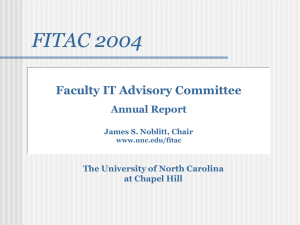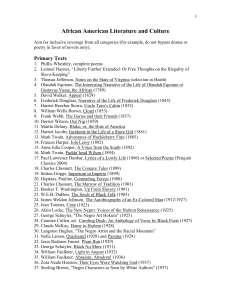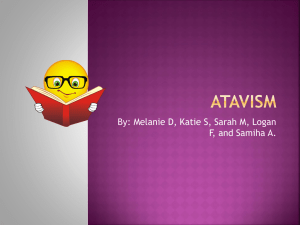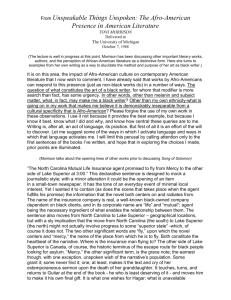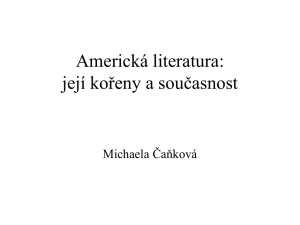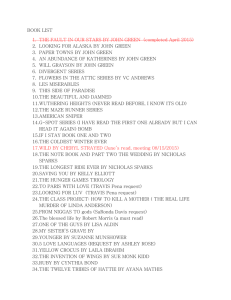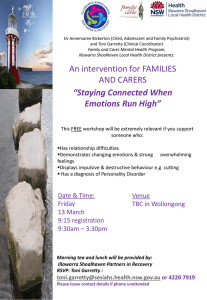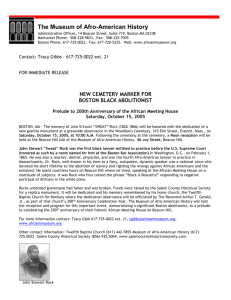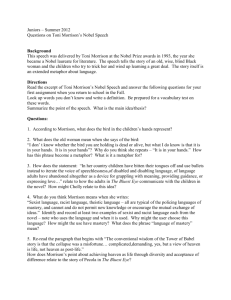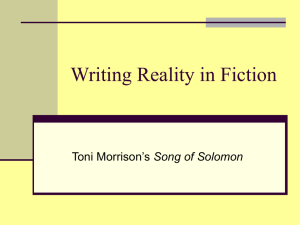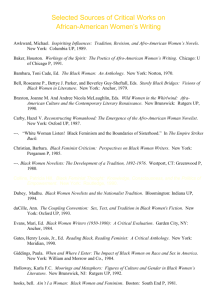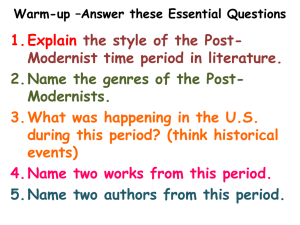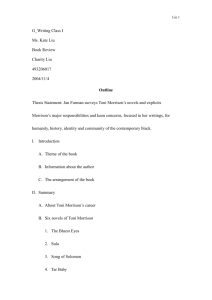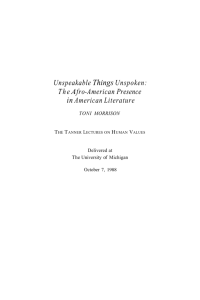INTRODUCTION TO AFRO-AMERICAN LITERATURE
advertisement
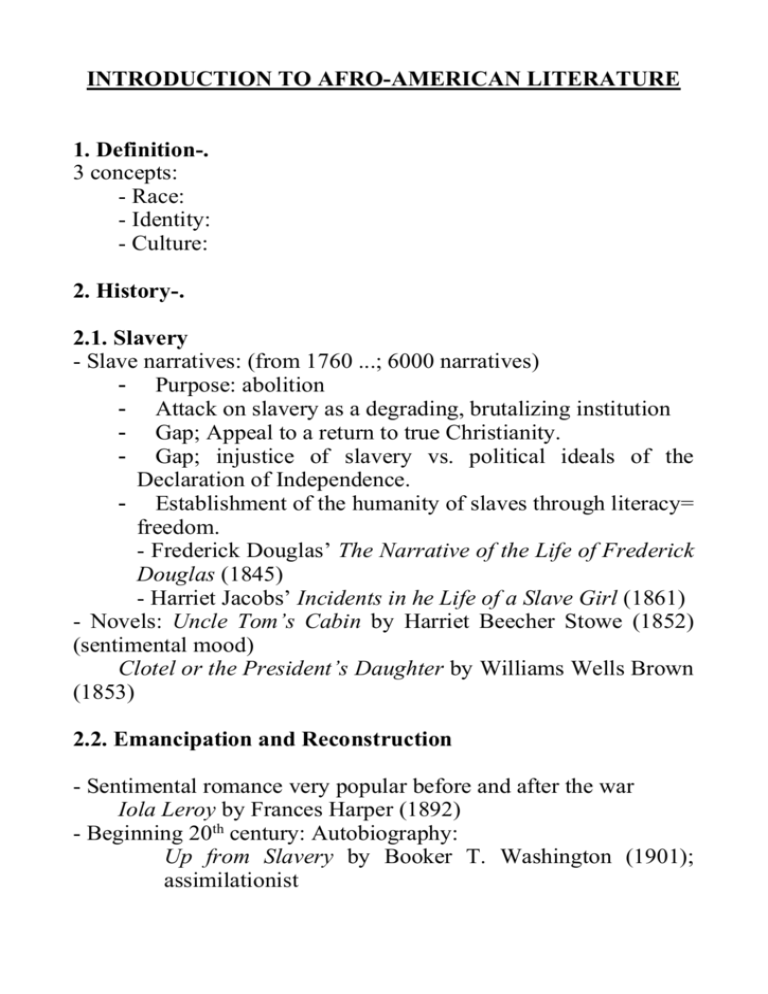
INTRODUCTION TO AFRO-AMERICAN LITERATURE 1. Definition-. 3 concepts: - Race: - Identity: - Culture: 2. History-. 2.1. Slavery - Slave narratives: (from 1760 ...; 6000 narratives) - Purpose: abolition - Attack on slavery as a degrading, brutalizing institution - Gap; Appeal to a return to true Christianity. - Gap; injustice of slavery vs. political ideals of the Declaration of Independence. - Establishment of the humanity of slaves through literacy= freedom. - Frederick Douglas’ The Narrative of the Life of Frederick Douglas (1845) - Harriet Jacobs’ Incidents in he Life of a Slave Girl (1861) - Novels: Uncle Tom’s Cabin by Harriet Beecher Stowe (1852) (sentimental mood) Clotel or the President’s Daughter by Williams Wells Brown (1853) 2.2. Emancipation and Reconstruction - Sentimental romance very popular before and after the war Iola Leroy by Frances Harper (1892) - Beginning 20th century: Autobiography: Up from Slavery by Booker T. Washington (1901); assimilationist Souls of Black Folk by W.E. B. Dubois (1903) “double consciousness” 2.3. Harlem Renaissance 20s: migration to the North (economic depression, deteriorating racial situation in the south; Harlem phenomenon; expanding job market in the North, provoked by WWI (myth) – Feeling of “racial pride” political reorientation headed by Dubois and the “Niagara Movement,” precursos of NAACP= a spirit of negro protest and self-assertion – New vision of literature as a protest instrument – Alain Locke's The New Negro ( ed 1925) – Poetry: Counteen Cullen, Jean Toomer, Claude McKay, Langston Hughes, Gerogia Johnson and Angelina Grinke – “Passing novel”-. James Weldon Johnson's Autobiography on an Ex-colored Man (1912); Nella Larsen's Quicksand and Passing (1928-1929) and Jessie Fauset's Plum Bun (1928) – Zora Neale Hurston2.4. 40s and 50s – Second wave of the Great migration (WWII) fall of colonialism and new African republics Ghana, Nigeria, Senegal and Algeria. – Improvementof racial situation = Truman's creation of the Commission on Civil Rights in 1947, desegregation by Court's decision. – Black ghettoes in northern cities -> black urban culture -> 'hip talk' – Richard Wright's Native Son (1940): commerical success; social realism and naturalism – William Attaway, Chester Himes. James Baldwin, Ann Petry's The Street (1946), Gwendolyn Brooks' Annie Allen (1950), Lorraine Hansberry's drama A Raisin in the Sun (1959) – Ralph Ellison's Invisible Man (1952) 2.5. The 60s or the Black Arts Movement – Conflicts inside and outside the US: Civil rights movement (ML King) and the Black Power Agiation (Malcolm X). Optimism ended with their assassination (1968 , 1965). The Vietnam War. – “Black Power” -> Black Panther Party for Self-Defense , gospel of the gun. – Black Arts Movement: search for inspiration in the masses; committed to social and political goals. Influential writers: Amiri Baraka and Nikki Giovanni. Fiction: John A. Williams The Man Who Cried I Am (1967). Critics: Larry Neal and Hoyt Fuller 2.6. From the 70s onwards – more local – Main trends: – 1. Return to the past, reclaiming past traditions: John Blassinggame's The Slave Community (1972), Gerda Lerner's Black Women in America (1973). – Writers: Alice Walker's In Search of Our Mother's Garden (1974); Toni Morrison's Song of Solomon (1977) and Beloved (1987). – 2. Exploration of Afro-American flok forms; African belief systems and rituals Alice Walker's The Colour Purple, The Temple of My Familiar, Possessing the Secret of Joy or Gloria Naylor's Mama Day or Ntozake Shange's Sassafrass, Cypress and Indigo.Music and orla traditions incorporated to contemporary works. – 3. Acknowledgement of Afro-American women writers. Interrelation between sexism and racism; Definition AfroAmerican female identity; double discrimiantion; break with silence and oppression – 4. Multiplicity of Afro-American identities: multiplicity inherent in Afro-American identity – 5. Critical theory and scholarship: Robert Stepto, Henry Luois Gates, Mary helen Washington, Hazel Carby and Toni Morrison. 3. Contemporary Afro-American women writers – – – – – – Toni Morrison's Nobel Prize in 1993; Rita Dove Poet Laureate of the United States. Women's Literature boom: origin-> I Know Why the Caged Bird Sings by Maya Angelou (1970) anthology The Black Women by Toni Cade Bambara; Toni Morrison's The Bluest Eye, Alice Walker's The Third Life of Grange Copeland and June Jordan His Own Where. Issues addressed: Concept of 'difference', concept of gender, relationships black men and women; reconstruction of history and culture from a female point of view, redefinition of women's identity rejecting stereotypes. Reconstruction of an Afro-American female literary tradition Themes and concerns: – Rejection of negative images of black women – Relationships between black men and black women – Importance of female sexuality and its relation to the process of creation and writing. – relationship to other women and the litereaty tradition before. – importance of a female tradition
